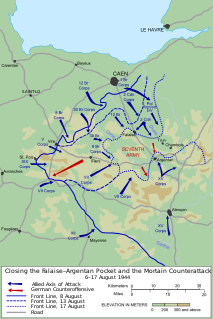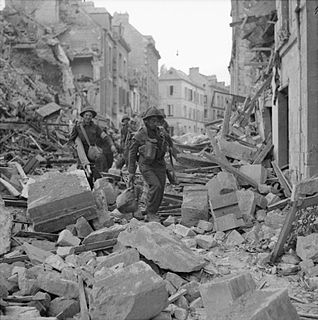This is the order of battle for the Operation Perch, a World War II operation between British and German forces in Normandy, France between June 6 and June 19, 1944.
General Officer Commanding-in-Chief: General Sir Bernard Montgomery [1]
Chief of the General Staff: Freddie de Guingand
General Officer Commanding-in-Chief: Lieutenant-General Miles Dempsey [1]
Lieutenant-General John Crocker
Lieutenant-General Gerard Bucknall

Operation Goodwood was a British offensive in the Second World War, that took place between 18 and 20 July 1944 as part of the battle for Caen in Normandy, France. The objective of the operation was a limited attack to the south, from the Orne bridgehead, to capture the rest of Caen and the Bourguébus Ridge beyond. At least one historian has called the operation the largest tank battle that the British Army has ever fought.

Michael Wittmann was a German Waffen-SS tank commander during the Second World War. He is known for his ambush of elements of the British 7th Armoured Division, during the Battle of Villers-Bocage on 13 June 1944. While in command of a Tiger I tank, Wittmann destroyed up to fourteen tanks and fifteen personnel carriers, along with two anti-tank guns, within the space of fifteen minutes. The news was picked up and disseminated by the Nazi propaganda machine and added to Wittmann's stature in Germany.

The 7th Armoured Division was an armoured division of the British Army that saw distinguished active service during World War II, where its exploits in the Western Desert Campaign gained it the Desert Rats nickname.

The Battle of Villers-Bocage took place during the Second World War on 13 June 1944, one week after the Normandy Landings, which had begun the Western Allies' conquest of German-occupied France. The battle was the result of a British attempt to improve their position by exploiting a gap in the German defences west of the city of Caen. After one day of fighting in and around the small town of Villers-Bocage and a second day defending a position outside the town, the British force retreated.

Operation Epsom, also known as the First Battle of the Odon, was a British offensive in the Second World War between 26 and 30 June 1944, during the Battle of Normandy. The offensive was intended to outflank and seize the German-occupied city of Caen, an important Allied objective, in the early stages of Operation Overlord, the Allied invasion of north-west Europe.

Operation Totalize was an offensive launched by Allied troops in the First Canadian Army during the later stages of Operation Overlord, from 8 to 9 August 1944. The intention was to break through the German defences south of Caen on the eastern flank of the Allied positions in Normandy and exploit success by driving south, to capture the high ground north of the city of Falaise. The goal was to collapse the German front and cut off the retreat of German forces fighting the Allied armies further west. The battle is considered the inaugural operation of the First Canadian Army, which had been activated on 23 July.

XXX Corps was a corps of the British Army during the Second World War. The Corps was formed in the Western Desert in September 1941. It provided extensive service in the North African Campaign and many of its units were in action at the Second Battle of El Alamein in late 1942. It then took part in the Tunisia Campaign and formed the left flank during the Allied invasion of Sicily in 1943.

The 15th (Scottish) Infantry Division was an infantry division of the British Army that served during the Second World War. It was raised on 2 September 1939, the day before war was declared, as part of the Territorial Army (TA) and served in the United Kingdom and later North-West Europe from June 1944 to May 1945.

The Falaise Pocket or Battle of the Falaise Pocket was the decisive engagement of the Battle of Normandy in the Second World War. A pocket was formed around Falaise, Calvados, in which the German Army Group B, with the 7th Army and the Fifth Panzer Army were encircled by the Western Allies. The battle is also referred to as the Battle of the Falaise Gap. The battle resulted in the destruction of most of Army Group B west of the Seine, which opened the way to Paris and the Franco-German border for the Allied armies on the Western Front.

Operation Charnwood was an Anglo-Canadian offensive that took place from 8 to 9 July 1944, during the Battle for Caen, part of the larger Operation Overlord in the Second World War. The operation was intended to capture the German-occupied city of Caen, which was an important objective for the Allies during the opening stages of Overlord. It was also hoped that the attack would forestall the transfer of German armoured units from the Anglo-Canadian sector to the American sector to the west, where an offensive was being prepared. The British and Canadians advanced on a broad front and by the evening of the second day had taken Caen up to the Orne and Odon rivers.

Operation Bluecoat was a British offensive in the Battle of Normandy, from 30 July until 7 August 1944, during the Second World War. The geographical objectives of the attack, undertaken by VIII Corps and XXX Corps of the British Second Army, were to secure the road junction of Vire and the high ground of Mont Pinçon.

The Battle for Caen is the name given to fighting between the British Second Army and the German Panzergruppe West in the Second World War for control of the city of Caen and vicinity, during the larger Battle of Normandy. The battles followed Operation Neptune, the Allied landings on the French coast on 6 June 1944 (D-Day). Caen is about 9 mi (14 km) inland from the Calvados coast astride the Orne River and Caen Canal, at the junction of several roads and railways. The communication links made it an important operational objective for both sides. Caen and the area to the south is flatter and more open than the bocage country in western Normandy; Allied air force commanders wanted the area captured quickly to base more aircraft in France.

Operation Atlantic was a Canadian offensive during the Battle of Normandy in the Second World War. The offensive, launched in conjunction with Operation Goodwood by the Second Army, was part of operations to seize the French city of Caen and vicinity from German forces. It was initially successful, with gains made on the flanks of the Orne River near Saint-André-sur-Orne but an attack by the 4th and 6th Canadian Infantry Brigades of the 2nd Canadian Infantry Division, against strongly defended German positions on Verrières Ridge to the south was a costly failure.

Operation Perch was a British offensive of the Second World War which took place from 7 to 14 June 1944, during the early stages of the Battle of Normandy. The operation was intended to encircle and seize the German occupied city of Caen, which was a D-Day objective for the British 3rd Infantry Division in the early phases of Operation Overlord. Operation Perch was to begin immediately after the British beach landings with an advance to the south-east of Caen by XXX Corps. Three days after the invasion the city was still in German hands and the operation was amended. The operation was expanded to include I Corps for a pincer attack on Caen.

The 44th Infantry Brigade was an infantry brigade of the British Army that saw active service in both World War I and World War II with 15th (Scottish) Division.
This is the order of battle for the Battle of Villers-Bocage, a World War II battle on 13 June 1944 between British and German forces in Normandy, France as part of Operation Perch.

Operation Martlet was part of a series of British attacks to capture the French town of Caen and its environs from German forces during the Battle of Normandy of World War II begun by the Allies. It was a preliminary operation undertaken on 25 June 1944 by XXX Corps of the British Second Army, to capture Rauray and the area around Noyers. The attack was to protect the right flank of VIII Corps as it began Operation Epsom, an offensive into the Odon Valley west of Caen, on 26 June. The 50th (Northumbrian) Infantry Division and the 49th Infantry Division were to capture Juvigny-sur-Seulles, Vendes and Rauray, to prevent German counter-attacks against VIII Corps from the area of the Rauray Spur and then extend the attack towards Noyers and Aunay-sur-Odon. It was the first time in Normandy that the 49th Division operated as a division.
This is the order of battle for Operation Epsom, a Second World War battle between British and German forces in Normandy, France between 26 June and 30 June 1944.

The Battle of Le Mesnil-Patry during the Second World War, was the last attack by an armoured battle group conducted by Canadian troops in Normandy in June 1944. The Queen's Own Rifles of Canada of the 8th Canadian Infantry Brigade of the 3rd Canadian Division, supported by the 6th Armoured Regiment of the 2nd Canadian Armoured Brigade attacked the village of Le Mesnil-Patry in Normandy, to advance southwards towards the higher ground of Hill 107 to the west of Cheux. The attack was intended to support a larger operation by the 50th (Northumbrian) Infantry Division and the 7th Armoured Division to capture the city of Caen and to advance in the centre of the bridgehead next to the First US Army. The battle was a German defensive success but the greater German objective of defeating the invasion by a counter-offensive also failed.

The Second Battle of the Odon comprised operations fought by the Second Army during the Second World War Attacks took place in mid-July 1944 against Panzergruppe West as part of the Battle of Normandy. Operations Greenline and Pomegranate were intended to draw German attention away from Operation Goodwood, an attack from the Orne bridgehead on 18 July.